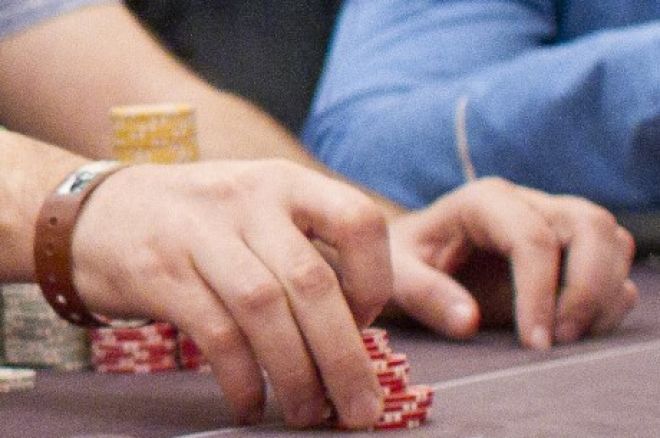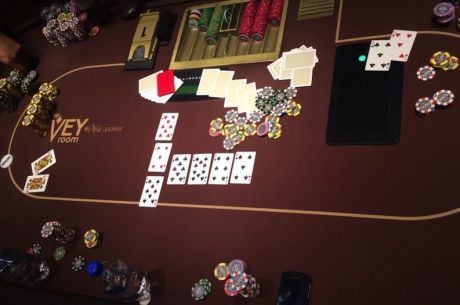Three Ways to Exploit Novice Players

Thanksgiving is approaching, which reminds me of last year when I had the opportunity to reconnect with some old friends in my hometown over the holiday. In between watching football and eating turkey, we played some poker, too, sitting down for $0.50/$1 no-limit hold’em cash game. The game was comprised of a couple of buddies with whom I played growing up as well as several players who were either brand new or fairly new to poker.
Needless to say, I found the evening to be quite a profitable experience as most of the players had little knowledge of the game, making it remarkably easy to find cracks and exploit them. I thought I would share some of the ideas I rediscovered during the game, in particular three not-so-complicated strategies that in many situations can help you to crush the casual player and dominate your home game.
1. Continuation Betting
By now, the continuation bet has become a totally standard move utilized most of the time by most players in the game — that is, when you make a raise before the flop and then continue out on the flop with another bet, regardless of the community cards and/or the strength of your hand. It’s a bet that enables you to keep the “lead” in the hand, allowing you to continue representing strength and, more often than not, to buy the pot after you missed the flop.
This move truly does wonders in terms of picking up small pots against beginning players. More often than not, beginners will fold their hands on the flop to a bet if they do not pair up. As Matthew Pitt was discussing here not long ago, new players tend to think on a “first-level” basis, focusing mainly on trying to make a hand and not much or at all about their opponents’ hands (“second-level” thinking). And so when the first three community cards don’t make them a hand, they’ll likely throw away their cards to that “c-bet.”
This simple move leads to immense profitability, as novice players are letting you scoop up small pot after small pot. These tiny pots are essentially free money awarded to you simply for continuing on with your hand.
2. Floating in Position
While most of the players in this game did not understand the concept of continuation betting, there were a couple who would occasionally make continue bet themselves. It was against these players that floating became a useful tactic.
Floating refers to calling an opponent’s bet after the flop — really without much regard for your own cards or whether you’ve made a hand — with the idea of seeing exactly how your opponent will play the hand on subsequent streets. If you think it is possible your opponent is continuing out weak, there is a chance that becoming aggressive on subsequent streets will induce a fold from your opponent and allow you to pick up a the pot without a showdown.
Beginning players who opt to utilize a continuation bet will often slow down on the turn if their hand has still not improved. The turn, then, becomes the optimal time to take the initiative in the hand and try to pick up the pot after you have “floated” the flop with a call.
3. Pressuring Those Who Are Afraid to Lose Their Stacks
New players in home cash games usually aren’t looking to risk a ton of money, and this aversion to risk often leads them to play scared. Players who sit down and are only willing to lose at most one buy-in will often wait and try to get their money in as good as possible. This mentality can lead to passive play and truly allow an aggressive player to take control of the game.
During our Thanksgiving cash game, there was a certain player who continued to raise with any hands comprised of two big cards. He would then check the flop after he missed and fold face up to a continuation bet, showing the table that he was frustrated after failing to connect with the board. Losing small pot after small pot led his stack to bleed.
In fact, he was making several mistakes that weren’t too hard to exploit — only raising with the same category of hands, always check-folding after missing flops, and routinely showing his cards unnecessarily, thereby letting everyone know exactly how he was playing.
As the night wore on, I engaged in a pot with him in which he led out on a flop with top pair and a poor kicker. I knew he was playing passively and afraid to lose his stack, so I put in a substantial raise. He lamented his situation, counted his short stack several times, and finally opted to lay his hand down to look for a better spot. I opted not to show my nine-high, for sake of continuing to reap profits off of his passive play.
If players are afraid to lose their stacks while they play, it will affect their judgment and their play will become worse because of it. Playing scared is no way to play the game at all. This behavior is among the most exploitable of beginning players.
Conclusion
None of these moves are terribly advanced in and of themselves, but against inexperienced players they can nonetheless prove most profitable. In fact, against novices who play predictably and/or passively, it is probably best to stick with such simple strategies as a means to take advantage of their exploitable tendencies.
Get all the latest PokerNews updates on your social media outlets. Follow us on Twitter and find us on both Facebook and Google+!








